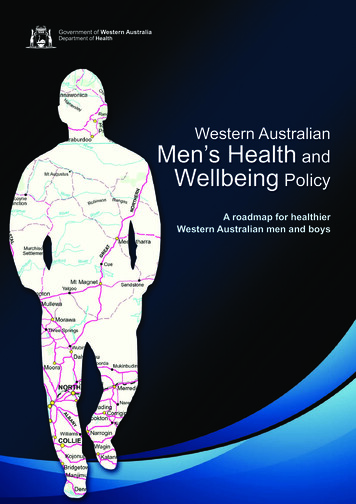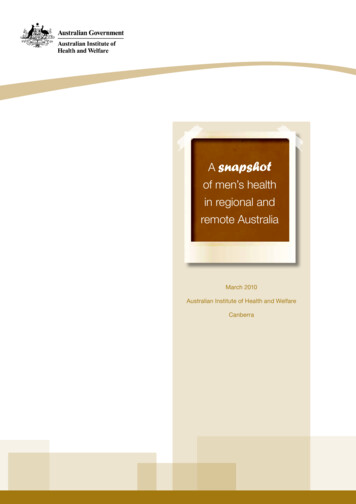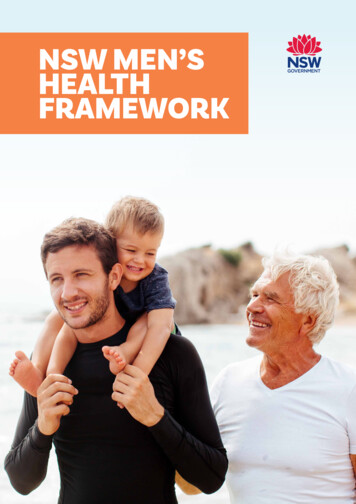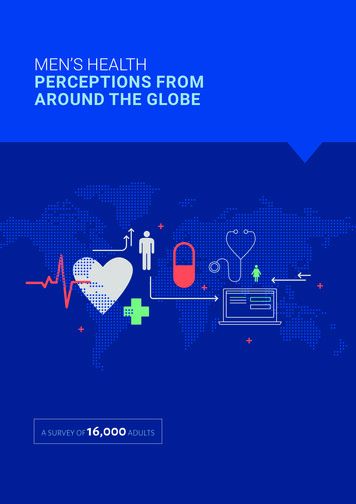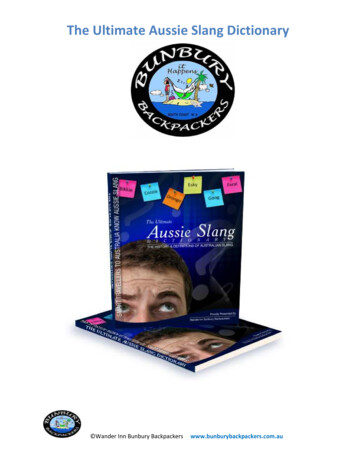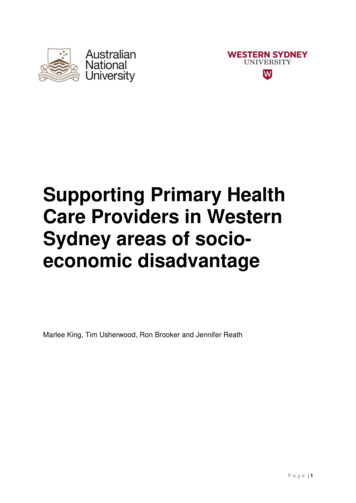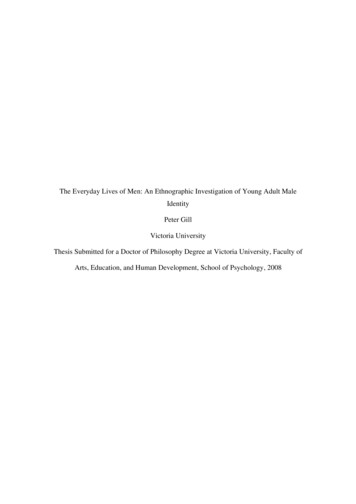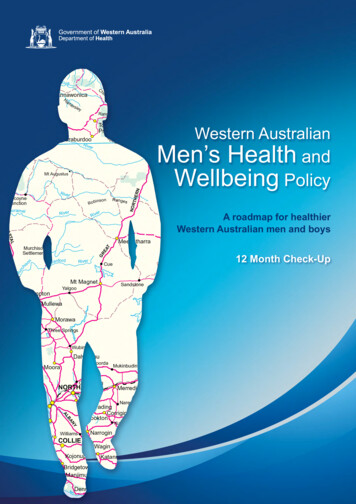
Transcription
Western AustralianMen’s Health andWellbeing PolicyA roadmap for healthierWestern Australian men and boys12 Month Check-Up
Produced by Health Networks WA Department of Health 2020Copyright to this material is vested in the State of Western Australia unless otherwise indicated. Apartfrom any fair dealing for the purposes of private study, research, criticism or review, as permitted underthe provisions of the Copyright Act 1968, no part may be reproduced or re-used for any purposeswhatsoever without written permission of the State of Western Australia.Suggested citationWestern Australian Department of Health. Western Australian Men’s Health and Wellbeing Policy:12 Month Check-Up. Perth: Health Networks, Western Australian Department of Health; 2020.Important disclaimerAll information and content in this Material is provided in good faith by the Western AustralianDepartment of Health, and is based on sources believed to be reliable and accurate at the time ofdevelopment. The State of Western Australia, the Western Australian Department of Health and theirrespective officers, employees and agents, do not accept legal liability or responsibility for the Material,or any consequences arising from its use.Contact informationFor further information contact Health Networks, Western Australian Department of Health on(08) 9222 0200 or healthpolicy@health.wa.gov.auAcknowledgement (map cover) 2010 Western Australian Land Information Authority.Base layer reproduced by permission of the Western Australian Land Information Authority.
ContentsExecutive ribution of the Survey Link5Data Collection5Data Analysis5Interpretation of Results5Results6Responses6Demographics6Awareness of the Policy7Activities and Action Areas10Opportunities and ix 1: Copy of the Survey17Appendix 2: Communication of the Survey2312 Month Check-Up 1
Executive SummaryThe Western Australian Men’s Health and Wellbeing Policy1 (the Policy) was designed to provide directionto the Western Australian (WA) health system and its partners to deliver strategies that improve thephysical, mental, social and emotional wellbeing of men and boys living in WA. The Policy was releasedduring Men’s Health Week in June 2019.The first anniversary of the launch of the Policy was celebrated during Men’s Health Week in 2020.The WA Department of Health continues to work with stakeholders to promote the Policy and itsimplementation. A 12 Month Check-Up of the Policy was carried out to assist in understanding:***the level of awareness of the Policymen’s health and wellbeing related activities that have been carried out in the previous12 monthsany issues and/or opportunities regarding the Policy that have arisen.An on-line survey was developed and was open for a period of five weeks (24 August - 25 September2020). A total of 37 responses were submitted. This 12 Month Check-Up Report details the resultsof the feedback that was received.Some key findings related to awareness of the Policy included:****62% of respondents indicated they were aware of the Policyof the respondents who were aware of the Policy (n 23), 44% attended the launch of the Policy,35% provided feedback on a draft of the Policy and 35% reported that it was a Policy documentused by my organisation or workplace65% of respondents who were aware of the Policy had read either most or all of the contentof the Policy83% of respondents who were aware of the Policy were either “somewhat familiar,”“moderately familiar” or “extremely familiar” with the content of the Policy.A variety of activities occurred over the last 12 months to support men’s health and wellbeing including:**activities during Men’s Health Week (15-21 June 2020)the development of a series of Podcasts to encourage and empower men and thecommunity to take responsibility for improving lives*a wide variety of community events*distribution of summary copies of the Policy to community and health providers*on-line events*existing support services for men aligned to the Policy’s intent*an on-line directory of services available to men and boys in WA.Over 75% of respondents believed the Policy was either “moderately useful,” “very useful” or“extremely useful” in the domains of reorientating health services, developing personal skills,strengthening community actions, creating supportive environments and building healthy public policy.2 12 Month Check-Up
Most of the suggestions to improve access to, use or implementation of the Policy related to eitherpromoting the Policy (e.g. to health professionals, community groups and industry) or resourcing ofthe Policy (e.g. financial support to hold more forums in the community).Barriers to accessing, using or implementing the Policy included:*the COVID-19 pandemic*a lack of awareness of the Policy*resourcing limitations*the need for implementation plans.Although the COVID-19 pandemic led to difficulties in promoting and implementing the Policy, it didprovide an opportunity for organisations to develop and reproduce resources on an on-line platform.Overall, this Report indicates that the majority of respondents were aware of the Policy and mostpeople had some level of familiarity with its content. Despite the challenges of implementing the Policy(especially during the COVID-19 pandemic), a wide variety of men’s health and wellbeing events haveoccurred in the previous 12 months. The feedback was supportive of the purpose of the Policy as itprovides a good framework to support the health and wellbeing of men and boys living in WA.12 Month Check-Up 3
BackgroundThe Policy was developed by the Health Networks Unit, Clinical Excellence Division, WA Department ofHealth. The purpose of the Policy is to provide direction to the WA health system and its partners todeliver strategies to improve the physical, mental, social and emotional wellbeing of men and boys livingin WA.The Policy is the first of its kind in WA and outlines the Department of Health’s response to the NationalMale Health Policy: Building on the strengths of Australian males2 and the action areas of the then draftNational Men’s Health Strategy 2020-2030.3 The final National Men’s Health Strategy 2020-20304 hassince been released.The Policy is the result of an intensive phase of research, discussion and consultation with manystakeholders as detailed in the Western Australian Men’s Health and Wellbeing Policy – CommunityConsultation Report.5The Policy was launched in Men’s Health Week, 10-16 June 2019. The WA Department of Health providedfunding to support six organisations to plan and undertake a men’s health event to launch the Policy.These organisations included:1. Kimberley Aboriginal Medical Service (KAMS), Bidyadanga Men’s Wellness Centre2. Men’s Health and Wellbeing WA3. Yanchep Community Men’s Shed4. Centacare Family Services, Geraldton5. Wyalkatchem Men’s Shed6. WA AIDS CouncilThe WA Department of Health supported the implementation of the Policy by communicating it acrossthe WA health system and to all relevant stakeholders. It has assisted with many enquiries from acrossthe sector requesting guidance for implementing the Policy’s recommendations and has raised the profileof the Policy via a variety of internal and external promotional opportunities. A copy of the Policy isavailable on the WA Department of Health website.PurposeThe first anniversary of the launch of the Policy was celebrated during Men’s Health Week, 15-21 June2020. The WA Department of Health continues to work with stakeholders to promote the Policy and itsimplementation.The WA Department of Health wanted to undertake a 12 Month Check-Up to monitor the Policy andassist in understanding:***the level of awareness of the Policymen’s health and wellbeing related activities that have been carried out in the previous12 monthsany issues and/or opportunities regarding the Policy that have arisen.This 12 Month Check-Up Report details the results of the feedback that was received.4 12 Month Check-Up
MethodologySurveyAn on-line, self-completion survey was developed to address the aims of the 12 Month Check-Up.A copy of the questionnaire is provided in Appendix 1. Citizen Space was used to design thequestionnaire and collect responses. A hard copy of the survey was available on request.Distribution of the Survey LinkA link to the survey, inviting individuals or organisations to participate, was distributed via the followingmechanisms:*targeted email to stakeholders - emailed on 24 August 2020*targeted email to stakeholders: Reminder – emailed on 21 September 2020*Health Point article – available on 24 August 2020*Health Networks Bulletin – emailed to over 4000 recipients on 2 September 2020****Health Point banner (with reference to the Health Point article) – displayed from27 August – 1 September 2020Health Happenings (with reference to the Health Point article) – emailed 27 August 2020Health Happenings: Reminder (with reference to the Health Point article) –emailed 3 September 2020COVID-19 staff update (with reference to the Health Point article) –emailed on 4 September 2020Health Point, Health Happenings and the COVID-19 staff update were communicated to WA public healthsystem staff. The text for selected forms of communication is outlined in Appendix 2. The consultationwas open to all areas of the WA health system, any organisations and/or individuals. Recipients of thelink were encouraged to share the link to the survey with others.Data CollectionData collection for the 12 Month Check-Up was opened on 24 August 2020. The survey was open for aperiod of five weeks and closed on 25 September 2020.Data AnalysisData from the survey was downloaded from Citizen Space. Quantitative data was analysed usingMicrosoft Excel. Qualitative data was analysed using thematic analysis to identify recurring themes thatrepresented common views of the respondents.Interpretation of ResultsThe results presented in this Report are predominately a descriptive account of the qualitative andquantitative data. The sum of percentages may not equal 100 due to number rounding.The methodology undertaken for this survey affects how the results can be interpreted. In particular,generalising results from the survey to the broader population is not appropriate because a selectedsample approach has been used.12 Month Check-Up 5
ResultsResponsesA total of 37 responses were received.DemographicsRespondents to the survey were asked to provide basic demographic information about their interestin the Policy (Figure 1), whether they were providing feedback from the perspective of an individualor organisation/group and their primary work place of work (Figure 2).Figure 1. What category best describes your primary interest in the Western Australian Men’s Healthand Wellbeing Policy?Other13%The policy is relevantto my work role54%I am a consumer ofmen’s health services27%I care for someone whouses men’s health services3%I am a family member orfriend of someone whouses men’s health services3%Most respondents indicated that their primary interest in the Policy was because “the Policy is relevantto my work role” (54%) or that “I am a consumer of men’s health services” (27%). Respondents in the“other” category included representatives of non-government and community organisations.Of the 20 respondents who indicated that the Policy was relevant to their work role, 50% wereproviding feedback from an individual perspective and 50% were providing feedback from agroup/organisational perspective.6 12 Month Check-Up
Figure 2. What category best describes your primary place of work?Other10%WA government agency15%Peak professional body15%Charitable organisation15%Commonwealthgovernment agency5%Non-government agency40%Of the 20 respondents who indicated that the Policy was relevant to their work role, 40% worked fora non-government agency and 15% each worked for either a WA government agency, a charitableorganisation or a peak professional body.Awareness of the PolicyTo measure awareness of the Policy, respondents to the survey were asked if they were previously awareof the Policy (Figure 3), how they were made aware of the Policy (Figure 4), how much of the Policy theyhad read (Figure 5) and familiarity of the content of the Policy (Figure 6).Figure 3. Before today, were you aware of the WA Men’s Health and Wellbeing Policy?No38%Yes62%Sixty two percent of respondents indicated they were aware of the Policy.12 Month Check-Up 7
Figure 4. How were you made aware of the Policy?*50%Percent40%30%20%10%0%I was amemberof theReferenceGroupI providedfeedback ona draft ofthe PolicyI attendedthe launchof thePolicyI discovered It is a policyIt wasit via andocument recommendedinternetused by my to me by ansearch/on organisation/ organisation/the webworkplace men’s interestgroupUnsure* Note: Percentages add up to more than 100% as multiple responses were allowed.Of the respondents who were aware of the Policy (n 23), 44% attended the launch of the Policy,35% provided feedback on a draft of the Policy and 35% reported that it was a Policy documentused by their organisation/workplace.8 12 Month Check-UpOther
Figure 5. How much of the Policy have you read?50%Percent40%30%20%10%0%None of the contentSome of the contentMost of the contentAll of the contentOf the respondents that were aware of the Policy (n 23), 65% had read either most or all of the contentof the Policy.Figure 6. How do you rate your familiarity with the content of the Policy?35%30%Percent25%20%15%10%5%0%Not at all familiarSlightly familiarSomewhat familiarModerately familiarExtremely familiarOf the respondents that were aware of the Policy (n 23), 83% were either “somewhat familiar,”“moderately familiar” or “extremely familiar” with the content of the Policy.12 Month Check-Up 9
Activities and Action AreasActivities to support men’s health and wellbeingRespondents were asked “What, if any, activities are you aware of that have occurred in WA over the last12 months to support men’s health and wellbeing?” Responses were varied and included:*men’s health activities during Men’s Health Week (15-21 June 2020)*a variety of activities by the Regional Men’s Health Initiative such as: development of a series of Podcasts about men’s health and wellbeing to encourage andempower men and the community to take responsibility for improving lives attendance at over 300 community events. Further information regarding selectedactivities can be accessed on the Regional Men’s Health Initiative website distribution of over 300 laminated summary copies of the Policy to community andhealth providers. The summary document can be accessed on the Western AustralianDepartment of Health website various conversations with stakeholders about the implications of the Policy*******approximately 20 in-person and online events to support men’s health and wellbeing werecarried out by Men’s Sheds of WAMen’s Outreach Service Aboriginal Corporation (MOSAC) provided a range of support servicesto men, their families and communities in the Kimberly region of WAMen’s Health and Wellbeing WA launched an on-line directory for a searchable listing of servicesavailable to men and boys in WA. The online directory is available on the Men’s Health andWellbeing WA websiteMen’s Health and Wellbeing WA launched a “Statement of Intent,” in November 2019, toencourage organisations to collectively improve the focus of the need for improvement in thehealth and wellbeing of men and boysParents Beyond Breakup and Dads in Distress provided assistance for separated dads includinga support helpline, online chat and forum, online support meetings and links to servicesthe delivery of a variety of other general programs that support men’s health, and social andemotional wellbeingthe development of various educational materials related to men’s health and wellbeing.Usefulness of the PolicyThe Policy outlines five policy domains to describe the broad areas of activities to support men’s healthand wellbeing. These include:10 1.Building healthy public policy including health, income and social policy to promote healthand make healthy choices easy2.Creating supportive environments including work and leisure that are safe and promotehealth3.Strengthening community actions including the involvement of communities in settingpriorities and making decisions to improve health outcomes12 Month Check-Up
4.Developing personal skills including information, education and skills to increase control forindividuals over their own health5.Reorienting health services to promoting health, not just focusing on illness, injury ordisease.Respondents were asked how useful the Policy was for the above domains based on their knowledge ofmen’s health and wellbeing in WA. The results are shown in Figure 7.in WA.Figure 7. Usefulness of the Policy in the five domains based on knowledge of men’s health andwellbeing in WA.your knowledgeof men's health and wellbeing in WA, how useful do you believe theBased on your knowledge of men’s health and wellbeing in WA, how useful do you believe the Policy isor the followingfor thedomains?following domains?Reorientingorienting healthserviceshealth servicesDevelopingeveloping personal skillspersonal skillsStrengtheningening communityactionscommunityactionsCreatingsupportive environmentssupportiveenvironmentsBuilding healthyding healthy publicpolicypublic policy0%10%20%30%40%50%60%70%80%90%100%Not at all usefulSlightly usefulModerately usefulVery usefulExtremely usefulExtremely usefulVery usefulSlightly usefulModerately usefulNot at all usefulpondents who answered the question, over 75% believed that the Policy was eitherthe useful”respondentswho answeredthe question,over 75%believed that the Policy was eitherely useful,” Ofveryor “extremelyuseful”in the abovedomains.“moderately useful,” “very useful” or “extremely useful” in the above domains.unities and Issuesents were asked to describe any opportunities or suggestions to improve the access to,plementation of the Policy; any issues or barriers in accessing, using or implementingand any additional feedback about the Policy. The main themes that emerged areed below. Direct quotations are provided in boxes.12 Month Check-Upities or suggestions to improve the access to, use or implementation of the Policy 11
Opportunities and IssuesRespondents were asked to describe any opportunities or suggestions to improve the access to, use orimplementation of the Policy; any issues or barriers in accessing, using or implementing the Policy andany additional feedback about the Policy. The main themes that emerged are summarised below. Directquotations are provided in boxes.Opportunities or suggestions to improve the access to, use or implementation of the PolicyTwenty-eight responses were received to Question 11 that asked respondents to “Please describe anyissues or barriers you are aware of in accessing, using or implementing the Policy.” Overall, most ofthe suggestions related to either promoting the Policy or resourcing the Policy. The comments aresummarised below.Promoting the PolicyA variety of comments related to the need to promote the Policy and suggestions included:*****organising local forumsarranging information sessions in towns and remote communities to explain the Policy in a waythat specific populations understandpromoting the Policy widely to health professionals (such as general practitioners), industryand community groupspromoting the Policy in all health and wellbeing circles (e.g. via public awareness campaigns,social media and at men’s meeting areas such as pubs, sporting clubs, men’s sheds andother organisations)mandating key elements of the Policy with Health Service Providers.“Public Awareness Campaign: helping communities understand thePolicy and its intent so that they may also encourage change in boththe public and private sectors at a grass-roots level.”Resourcing the PolicyThe importance of adequate resourcing of the Policy was also highlighted to improve the access to, useor implementation of the Policy. For example, financial support is required to hold more forums within thecommunity to be able to reach out to more men, and those around them, about their health.“12 The Policy needs funding and resources to be turned into reality 12 Month Check-Up”
Issues or barriers in accessing, using or implementing the PolicyRespondents were asked to describe any barriers in accessing, using or implementing the Policy.Twenty-seven responses were received. Several themes emerged including the restrictions imposedby the COVID-19 pandemic, a lack of awareness of the Policy, resourcing limitations and the need forimplementation plans.COVID-19 pandemicThe restrictions imposed by the COVID-19 pandemic have been identified as a barrier to promoting andimplementing the Policy.COVID-19 has put the Policy advertising and implementationon the back burner (like many other issues) It was also apparent that the COVID-19 pandemic has influenced how resources are shared. For example,The Blokes’ Book, which provides a directory of services available to men across a broad range of healthand wellbeing areas, was previously only available in printed format. It has now been adapted to anon-line Men’s Directory, in part due to COVID-19, thus assisting to overcome accessibility barriers.The Men’s Directory can be accessed at Men’s Health and Wellbeing WA.Lack of awarenessA lack of awareness of the Policy was considered a barrier to implementing and actioning the Policy.A lack of awareness a lack of actionResourcingResourcing limitations (funding and time) were also described as a barrier to promoting andimplementing the Policy.Lack of funding available to provide servicesfor men’s health and wellbeing, with a focuson prevention and education.Implementation PlanSome respondents raised concerns regarding the need for, and development of, implementation plansfor the Policy.For the promise of this excellent Policy to be realised, it needs animplementation strategy that is adequately resourced to enable someof the wisdoms the Policy enunciates.12 Month Check-Up 13
Additional or general feedback about the PolicyQuestion 13 asked respondents to provide any additional or general feedback about the Policy.Overall, the feedback was supportive of the initiation and development of the Policy as it provides a goodframework to support men’s health and wellbeing.“We have to greatly congratulate the WA State Government and (theMinister for Health) in particular, for initiating the Policy. Not enoughhas been done for men over the years and the WA Men’s Health andWellbeing Policy is a great initiative.”Some of the comments related to issues that had previously been raised in the survey including the needfor successful and measurable implementation and the challenges associated with it. These challengesincluded the need for effective resourcing and the implications of the Policy being non-mandatory withHealth Service Providers. Others acknowledged that changes occur gradually and to “Be not afraid ofgrowing slowly, be afraid of standing still.”It’s a great step forward, one that theGovernment and (the Department of Health)can be really proud of. It needs to beimplemented in full.The challenge isbringing suchdocuments to life.In addition, while some respondents believed the Policy was well promoted, others believed that it needsto be publicised more.Good policy. Well considered,well crafted. Well promoted.Needs to bepromoted more.Other comments referred to how the Policy has been used. For example, the principles and goals of thePolicy have been used by research organisations in the design of research projects involving men in WA.The Policy has also been used by organisations (e.g. Men’s Sheds of WA) to underpin their StrategicPlans to ensure activities remain centred on men’s health and wellbeing over the coming years. Thedocument has been promoted in individual Men’s Sheds, some of which have seen significant increasesin membership.Finally, some comments referred to men’s health and wellbeing activities planned for the near future. Forexample, a forum entitled Men. Healthier Together presented by Spinnaker Health Research Foundation(scheduled for 7 October 2020) aimed to discuss an integrated model of evidence-based research toimprove the physical, mental, social and emotional well-being of men and boys living in WA.14 12 Month Check-Up
DiscussionThis 12 Month Check-Up Report describes the level of awareness of the Policy, men’s health andwellbeing related activities that have been undertaken and any issues and/or opportunities regardingthe Policy that have arisen.The majority of respondents to the survey were aware of the Policy with many people indicating theyattended the launch event, used the Policy in their organisation or workplace, or provided feedback onthe draft Policy. Of those who were aware of the Policy, most had some level of familiarity with itscontent. Nevertheless, it should be noted that generalising results from the survey to the broaderpopulation is not appropriate because a selected sample approach has been used.It was evident that a wide variety of men’s health events and activities have occurred in the preceding12 months. Examples include events during Men’s Health Week, the development of a series ofpodcasts, a wide variety of community events, distribution of resource materials, building effectivestakeholder relationships, on-line events, various support services and the development of numerousonline resources to support the health and wellbeing of men and boys in WA. This list is by no meansexhaustive and the WA Department of Health is aware of many other activities that have occurred thathave not been reported within responses to the survey. These examples demonstrate how men, thecommunity, advocacy groups, health professionals and those who provide services for men can workcollectively towards improving men’s health and wellbeing.Many suggestions for further promoting the Policy were proposed including publicising the Policy tolocal community groups, health professionals and industry. Suggested methods for promoting the Policyincluded public awareness campaigns, social media and targeting men’s meeting areas such as pubs,sporting clubs, men’s sheds and other organisations. These suggestions should be considered in thecontext that the primary audience for the Policy is the WA health system.The results of the survey have also indicated that community engagement in relation to men’s healthand wellbeing activities during the COVID-19 pandemic has been very challenging. This has led todifficulties in promoting and implementing the Policy. However, COVID-19 did provide an opportunityfor organisations to review how resources are communicated with many resources being developed orreproduced for an on-line platform.Another barrier that influenced access, use and implementation of the Policy was a lack of awareness ofthe Policy although there was differing opinions regarding its promotion. Some respondents believed itwas well promoted while others believed that it needs to be publicised more. Resourcing limitations andthe need for successful and measurable implementation plans were also cited as barriers.Overall, this 12 Month Check Up Report indicates that the majority of respondents were aware of thePolicy and that most people had some level of familiarity with its content. The Report details a widevariety of men’s health and wellbeing events that have occurred in the previous 12 months despitenumerous challenges including the COVID-19 pandemic, resourcing limitations and the need forimplementation plans in relation to the Policy. The COVID-19 pandemic provided an opportunity forhealth and wellbeing information to be adapted to on-line platforms. The feedback was supportive of thepurpose of the Policy indicating it provides a good framework to support men’s health and wellbeing atan individual and organisational level.12 Month Check-Up 15
References1.Western Australian Department of Health. Western Australian Men’s Health and Wellbeing Policy.Perth: Health Networks, Western Australian Department of Health; 2019.2.Department of Health and Ageing. National Male Health Policy: Building on the strengths ofAustralian males. Canberra: Department of Health and Ageing; 2010.3.Commonwealth of Australia, Department of Health. National Men’s Health Strategy 2020-2030 Draft for public consultation. 2018.4.Commonwealth of Australia, Department of Health. National Men’s Health Strategy 2020-2030.Commonwealth of Australia, Department of Health; 2019.5.Western Australian Department of Health. Western Australian Men’s Health and Wellbeing Policy Community Consultation Report. Perth: Health Networks, Western Australian Department ofHealth; 2019.16 12 Month Check-Up
AppendicesAppendix 1: Copy of the SurveyWA Men’s Health and Wellbeing Policy: Annual Check-UpOverviewThe Western Australian Men’s Health and Wellbeing Policy (the Policy) was launched in Men’s HealthWeek 2019 (10-16 June). The purpose of the Policy is to provide direction to the WA health system andits partners to deliver strategies to improve the physical, mental, social and emotional wellbeing of menand boys in WA.The primary audience of the Policy is the WA health system. However, improvements in men’s healthrequire the involvement of a range of agencies beyond the WA health system working collaboratively toachieve common goals. Therefore, it is recommended that the approaches outlined within the Policy areadopted by multiple agencies.A copy of the Policy and Summary Document is available on the WA Department of Health’s website.https://ww2.health.wa.gov.au/Articles/U Z/WA-Mens-Health-and-Wellbeing-PolicyWhy we are consultingWe recently celebrated the first anniversary of the launch of the Polic
National Men's Health Strategy 2020-2030. 3 The final National Men's Health Strategy 2020-2030 4 has since been released. The Policy is the result of an intensive phase of research, discussion and consultation with many stakeholders as detailed in the . Western Australian Men's Health and Wellbeing Policy - Community . Consultation .

